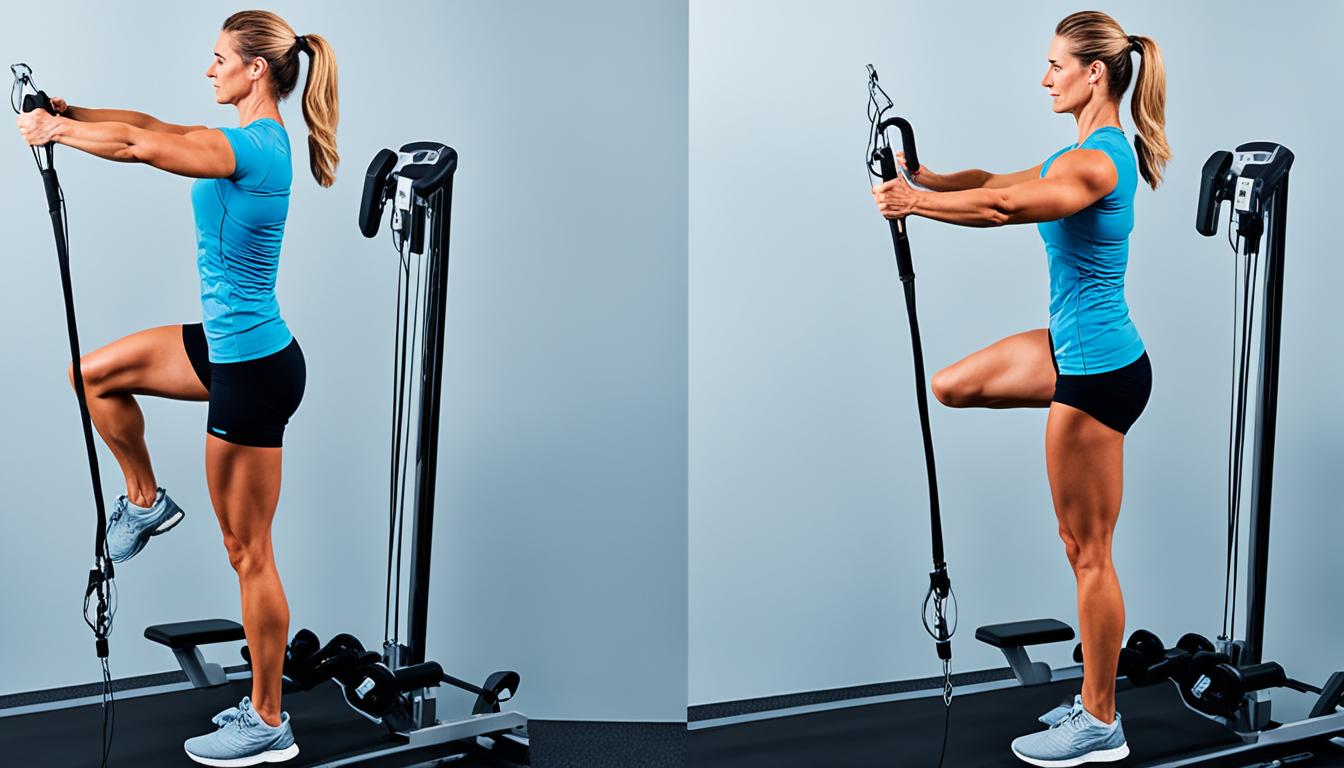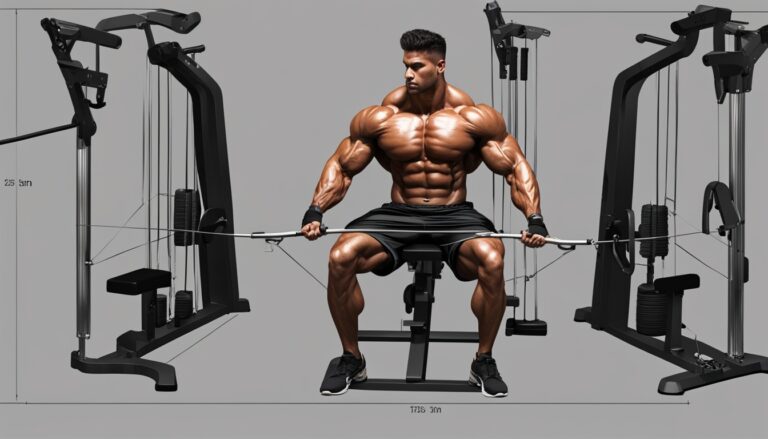Building strong and well-defined legs is essential for a balanced and powerful physique. The focus on hamstring strengthening should not be underestimated, as these muscles play a crucial role in numerous lower body movements and overall athletic performance. This comprehensive guide aims to introduce you to an effective cable workout for hamstrings, providing you with detailed insights and techniques to optimize your leg day routine. Whether you’re a fitness enthusiast or a casual gym-goer, incorporating cable exercises into your regimen can offer significant advantages for your hamstring development.
By utilizing cable machines, you can achieve constant tension on your muscles throughout the entire range of motion, enhancing muscle activation and growth. This guide will take you through various exercises and tips that can help you target your hamstrings effectively, ensuring you’re getting the most out of your workouts.
Key Takeaways
- Hamstring exercises are vital for overall leg strength and balance.
- Cable machines provide constant tension, improving muscle activation and growth.
- Incorporating cable workouts can diversify your leg day routine.
- Proper form and technique are essential for maximizing benefits and avoiding injuries.
- Adaptations and variations of exercises can cater to different fitness levels.
- Regularly updating your routine with new exercises can prevent plateaus.
Introduction to Hamstring Cable Workouts
The hamstrings play a critical role in our daily movements and physical stability. Understanding the importance of hamstring exercises is essential for achieving a balanced and effective fitness routine. Implementing cable machine workouts can offer unique benefits for targeting this muscle group.
Why Focus on Hamstrings?
The hamstrings, located at the back of the thighs, are involved in various movements such as walking, running, and jumping. Strengthening this muscle group can enhance athletic performance, prevent injuries, and improve overall lower body strength. Consistent hamstring exercises can lead to better posture and increased flexibility.
Benefits of Using a Cable Machine
Incorporating a cable machine into your hamstring workouts provides numerous advantages. One of the primary benefits is the ability to maintain constant tension on the muscles throughout the entire range of motion. This continuous resistance helps in maximizing muscle engagement and growth. Additionally, the controlled movements with a cable machine reduce the risk of injury compared to free weights.
Cable machine workouts also offer more versatility with exercise variations, allowing for comprehensive hamstring training. Whether you are performing standing leg curls, Romanian deadlifts, or hamstring curls, the cable machine ensures consistent resistance and stability.
By incorporating these hamstring exercises into your routine, you can achieve significant improvements in muscle strength, endurance, and overall leg development. Embrace the full potential of cable machine workouts to elevate your hamstring training to the next level.
Best Cable Exercises for Hamstrings
When it comes to strengthening hamstrings, cable exercises offer targeted and effective solutions. These exercises can be performed with precision, allowing fitness enthusiasts to isolate the hamstrings and achieve better muscle development. Let’s delve into three of the best cable exercises designed to bolster hamstring strength and flexibility.
Cable Pullthrough
The Cable Pullthrough is a pivotal exercise for hamstring and glute activation. By executing this move with a cable machine, you ensure constant tension throughout the movement, promoting muscle hypertrophy. Key points to remember include standing a few feet away from the cable machine, hinging at the hips, and maintaining a neutral spine as you pull the cable through your legs.
Glute-Ham Raise
The Glute-Ham Raise targets both the hamstrings and the glutes, making it a dual-benefit exercise. Using a cable machine enhances the resistance, offering a smooth, controlled movement. Position yourself on a Glute-Ham developer, attach the cable to your feet, and ensure your movements are deliberate and slow to maximize muscle engagement and prevent injury.
Bodyweight Hamstring Curls
Bodyweight Hamstring Curls, when incorporated with a cable machine, provide a potent workout for the hamstrings. Lie on the floor, hook the cable attachment to your ankles, and curl your legs towards your glutes. This version increases resistance, effectively challenging the muscles and contributing to better overall strength and endurance in the lower body.
By integrating these exercises into your routine, you can enhance the flexibility, strength, and definition of your hamstrings, making your lower body workouts both efficient and dynamic.
Cable Pullthrough: Techniques and Tips
The cable pullthrough is an excellent exercise for your hamstring muscles. I want to guide you through the proper execution to maximize the benefit of this workout while minimizing injury risks. A correct posture is crucial to engage the hamstring muscles effectively.
Proper Form and Execution
Executing the cable pullthrough accurately starts with your stance and grip. Here’s a step-by-step breakdown to ensure proper form:
- Stand facing away from the cable machine, feet shoulder-width apart.
- Grasp the handle with both hands between your legs, maintaining a neutral spine.
- Bend at the hips, allowing the cable to pull your hands back while maintaining a straight back and slightly bent knees.
- Engage the hamstrings and glutes, driving through the heels to return to the standing position.
- As you stand, squeeze your glutes and keep your shoulders back to complete the movement.
Common Mistakes to Avoid
While the cable pullthrough is a highly effective hamstring exercise, improper form can negate its benefits and cause injury. Here are some common mistakes to avoid:
- Rounding the back: This not only diminishes muscular engagement but also puts strain on the lumbar spine.
- Using the arms: The power should come from the hamstrings and glutes, not the arms or upper body.
- Locking the knees: Keep a slight bend in the knees to maintain continuous tension on your hamstrings.
- Incorrect hip hinge: Ensure that the motion is driven by bending at the hips, not the lower back.
By adhering to these guidelines, you can optimize your cable workout for hamstrings and achieve impressive results from your hamstring exercises. Always pay attention to form to enhance efficiency and prevent injury.
Incorporating Hamstring Exercises into Your Leg Day Routine
Incorporating hamstring exercises into your Leg Day Routine isn’t just about adding variety; it’s about maximizing muscle growth and ensuring balance. One effective approach is using Cable Machine Workouts. These workouts are excellent for targeting the hamstrings, providing constant tension and versatile movement patterns.
Start your leg day with compound movements like squats or leg presses to engage multiple muscle groups. Afterward, you can transition into more isolated hamstring exercises. For example:
- Begin with the Cable Pullthrough to activate your hamstrings and glutes.
- Next, incorporate Glute-Ham Raises using the cable machine for an added challenge.
- Finish with Bodyweight Hamstring Curls using the cable machine to ensure maximum muscle contraction.
It’s essential to understand how to properly sequence these exercises to avoid fatigue affecting your performance. Using cable machine workouts ensures a controlled environment, making it easier to maintain proper form and avoid injuries. For a more detailed guide on cable machine exercises, I recommend visiting this resource.
Regarding volume and frequency, aim to perform hamstring exercises 2-3 times per week, with around 3-4 sets of 8-12 repetitions per exercise. Be mindful of your recovery, as hamstring muscles can take longer to recover after intense workouts.
To further enhance your Leg Day Routine, consider adding variations of these exercises periodically. For instance, you might switch between single-leg and double-leg movements or adjust the grip and stance for different muscle activation angles. A well-rounded leg day not only builds strength but also reduces the risk of muscle imbalances.
| Exercise | Sets | Reps | Frequency |
|---|---|---|---|
| Squats | 3-4 | 8-12 | 2-3 times/week |
| Cable Pullthrough | 3-4 | 8-12 | 2-3 times/week |
| Glute-Ham Raise | 3-4 | 8-12 | 2-3 times/week |
| Bodyweight Hamstring Curls | 3-4 | 8-12 | 2-3 times/week |
Glute-Ham Raise with Cable Machine
The Glute-Ham Raise is a powerhouse exercise that targets the hamstrings, glutes, and lower back, making it a vital component of any serious leg workout routine. Through the strategic use of a cable machine, this exercise can be fine-tuned to suit different fitness levels and goals.
Step-by-Step Guide
Executing a Glute-Ham Raise with a cable machine involves a few precise steps for optimal muscle activation and safety:
- Set Up the Cable Machine: Attach an ankle strap to the low pulley and secure it around your ankles.
- Position Yourself: Kneel on a mat facing away from the machine, with the cable pulling from behind.
- Initial Position: Keep your torso upright with hands placed on your chest or behind your head.
- Execute the Movement: Slowly lower your upper body by hinging at the knees, maintaining a straight back.
- Return to Start: Engage your hamstrings and glutes to pull yourself back to the starting position.
Modifications for All Levels
The beauty of the Cable Workout For Hamstrings, specifically the Glute-Ham Raise, lies in its versatility. Modifying the exercise tailors it to various skill levels:
For Beginners
- Assisted Lowering: Use a resistance band for support when lowering your body.
- Partial Reps: Focus on shorter ranges of motion to build initial strength.
For Advanced Lifters
- Increased Resistance: Add weight plates to your torso for added challenge.
- Speed Variations: Incorporate slow negatives for eccentric overload.
Incorporating these modifications ensures that everyone, from novice gym-goers to seasoned athletes, can utilize the Glute-Ham Raise effectively. For more insights on comparing training methods, consider reading about the benefits of both cable workouts and free weights here.
Bodyweight Hamstring Curls Using Cable Machine
Bodyweight hamstring curls are an excellent exercise for targeting the hamstring muscles using minimal equipment. The cable machine offers a versatile platform for performing this exercise, allowing for smooth resistance and controlled movements. Let’s dive into the technique and variations for optimizing your hamstring workout.

How to Perform the Exercise
To perform bodyweight hamstring curls using a cable machine, follow these steps:
- Attach an ankle strap to the low pulley of the cable machine.
- Secure the strap around one ankle and stand facing the machine.
- Slowly bend your knee, bringing your heel towards your glutes while keeping your thigh stationary.
- Pause for a moment at the top of the curl, then gradually lower your foot back to the starting position.
- Repeat for the desired number of repetitions before switching legs.
Benefits and Variations
Integrating bodyweight hamstring curls into your cable machine workouts brings several benefits:
- Improved neuromuscular coordination: This exercise engages the mind-muscle connection, enhancing your awareness and control over the hamstring muscles.
- Isolation of the hamstrings: Using the cable machine effectively isolates the hamstrings, targeting muscle fibers that might be missed with other exercises.
- Versatility: Variations in curling techniques can cater to different fitness levels and goals.
For additional variations and a detailed guide, check out the best cable exercises for hamstrings. Adjusting the resistance and incorporating single-leg curls or isometric holds can further enhance your workout routine.
By consistently incorporating these exercises, you can strengthen and develop your hamstrings, leading to better overall leg stability and performance.
Complementary Exercises: Stiff-Legged Deadlifts
Incorporating Stiff-Legged Deadlifts into your hamstring training routine can significantly enhance your overall leg strength and flexibility. These exercises provide an excellent method for both hamstring strengthening and muscle lengthening, making them a valuable addition to any comprehensive leg workout plan.
Why Add Stiff-Legged Deadlifts?
Including stiff-legged deadlifts in your workout routine helps isolate and engage the hamstrings more effectively than many other exercises. This specific movement targets the posterior chain, promoting muscle hypertrophy and endurance. By emphasizing hamstring strengthening, you not only support better athletic performance but also lower the risk of injuries that can occur from muscle imbalances.
- Enhances overall hamstring strength
- Improves flexibility and muscle length
- Contributes to high-performance legs and reduced injury risk
Executing the Perfect Stiff-Legged Deadlift
Achieving optimal results with stiff-legged deadlifts requires impeccable form. Here’s a step-by-step guide to execute this exercise correctly:
- Stand with feet shoulder-width apart, holding a barbell with an overhand grip.
- Keep your legs straight but not locked, maintaining a slight bend in the knees.
- Hinge at the hips, pushing them back as you lower the barbell along the front of your legs.
- Lower the barbell to just below your knees or until you feel a stretch in the hamstrings.
- Engage your hamstrings and glutes to lift the barbell back to the starting position, keeping your back straight and shoulders retracted.
Maintaining proper form not only maximizes the benefits of stiff-legged deadlifts but also ensures you perform the exercise safely and effectively. Paying close attention to technique will contribute significantly to your hamstring strengthening efforts.
Romanian Deadlifts with Cables
Performing Romanian Deadlifts with cables offers a unique twist to the traditional free-weight version. This variation provides consistent resistance throughout the entire movement, which can be particularly beneficial for increasing muscle activation and strength gains. When using cables, the load is more evenly distributed, maintaining tension on the hamstring muscles even at the top of the exercise.

One major advantage of incorporating Romanian Deadlifts into your workout routine is the enhanced focus on the hamstring exercises. Cables allow for smoother transitions and less strain on the lower back while still effectively targeting the hamstrings and glutes.
Here’s how the Romanian Deadlift with cables compares to its free-weight counterpart:
| Aspect | Cable Romanian Deadlift | Free-Weight Romanian Deadlift |
|---|---|---|
| Load Distribution | Consistent throughout motion | Variable with gravity |
| Stabilization | Requires less core stabilization | Higher core engagement |
| Muscle Activation | Continuous tension on hamstrings | Peaks at certain points |
| Range of Motion | Controlled and smooth | Potentially less stable |
Incorporate Romanian Deadlifts with cables into your routine to diversify your hamstring exercises, ensuring consistent strength gains and muscle development.
Hamstring Strengthening Tips for Beginners
Starting a new exercise regimen can be daunting, but with proper guidance, beginners can make significant strides in hamstring strengthening using cable machine workouts. This section provides essential tips to safely and effectively train your hamstrings as you embark on your fitness journey.
Safety Precautions
Ensuring safety is paramount, particularly for those new to hamstring strengthening. Here are some crucial safety tips:
- Warm-Up Properly: Start with light cardio and dynamic stretches to prepare your muscles.
- Use Proper Form: Incorrect form can lead to injuries. Always pay attention to your posture and technique.
- Select Appropriate Weights: Choose weights that challenge you but allow you to maintain control and proper form.
Progression Strategies
Advancing in your cable machine workouts requires a thoughtful approach. Consider the following strategies to ensure steady and safe progress:
- Gradual Overload: Gradually increase the weight or resistance as your strength improves.
- Regular Monitoring: Track your progress to identify when it’s time to adjust your workouts.
- Variety in Exercises: Introduce new exercises or variations to keep your workouts interesting and target different muscle fibers.
The journey to stronger hamstrings begins with understanding the basics of safety and progression. By incorporating these tips into your routine, you can make the most of your cable machine workouts and lay a strong foundation for future strength gains.
Advanced Hamstring Workouts with Cable Machines
For experienced athletes, incorporating Advanced Hamstring Workouts into your routine can take your lower-body training to new heights. Using a cable machine allows for a range of motion and resistance that can specifically isolate the hamstrings, making it an ideal tool for advanced workouts.
To enhance the intensity, consider adding movements like lying leg curls and hamstring slides. These exercises, when properly executed, can significantly improve hamstring strength and definition.
Integrating a cable workout for hamstrings into your existing routine can ensure balanced muscle development and reduce the risk of injury. For instance, incorporating exercises such as toes-elevated dumbbell Romanian deadlifts can amplify your routine’s effectiveness.
“Proper form and progressive overload are crucial in advanced training to prevent injuries and maximize muscle growth,” says Dr. Stefi Cohen, world record holder in powerlifting.
The key to effective Advanced Hamstring Workouts is the combination of consistency and variety. Introducing different exercises and variations ensures that the muscles are continually challenged.
Here are some advanced movements to consider:
- Lying Leg Curls
- Hamstring Slides
- Toes-Elevated Dumbbell Romanian Deadlifts
To get the most out of your Advanced Hamstring Workouts, always track your progress and adjust the resistance to match your increasing strength. Utilizing tips and guidance from experts like Dr. Stefi Cohen can help maximize your performance.
Conclusion
In summary, integrating a Cable Workout For Hamstrings into your Leg Day Routine is a highly effective way to build strength, enhance muscle definition, and improve overall functional fitness. Throughout this guide, we have explored various exercises, including the cable pullthrough, glute-ham raise, and bodyweight hamstring curls, each offering unique benefits for targeting the hamstrings efficiently.
Using a cable machine can provide consistent resistance and flexibility in modifying exercises for all fitness levels. From beginners to advanced athletes, incorporating these exercises ensures that your hamstrings receive the focused attention they deserve, reducing the risk of injury and promoting balanced muscle development.
As you design or refine your Leg Day Routine, remember to include these cable exercises. By doing so, you’ll not only strengthen your legs but also improve your overall performance and mobility. Whether you’re aiming for muscle hypertrophy or simply looking to add variability to your workout, a comprehensive Cable Workout For Hamstrings is a wise addition to any fitness regimen.
FAQ
Why should I focus on hamstrings during my leg day routine?
Strengthening your hamstrings is crucial for a balanced physique and enhances overall lower body performance. Well-developed hamstrings stabilize the knees and hips, prevent injuries, and contribute to better movement efficiency.
What are the benefits of using a cable machine for hamstring exercises?
Cable machines provide constant tension throughout the entire range of motion, which maximizes muscle activation. They also offer controlled movements, reducing the risk of injury while allowing for more targeted and effective hamstring work.
How do I correctly perform a cable pullthrough?
To execute a cable pullthrough correctly, start by positioning yourself with your back to the cable machine, feet shoulder-width apart. Grasp the cable handle between your legs and hinge at the hips, maintaining a straight back. Engage your hamstrings and glutes to pull through and return to the starting position.
What common mistakes should I avoid during a cable pullthrough?
Avoid rounding your lower back, locking your knees, and using excessive weight that compromises form. Ensure you are hinging at the hips and not squatting, and keep a controlled pace to maximize the effectiveness of the exercise.
How can I integrate hamstring exercises into my leg day routine?
Incorporate hamstring exercises such as cable pullthroughs, glute-ham raises, and bodyweight hamstring curls at the beginning or middle of your leg day workout. Aim for 2-3 sets of each exercise with 8-12 repetitions, depending on your fitness level and goals.
What modifications can I make for a glute-ham raise using a cable machine?
Beginners can start with a lower weight and shorter range of motion, gradually increasing as strength improves. Advanced users can elevate their feet or add resistance bands to increase difficulty, ensuring they constantly challenge their muscles.
How do I perform bodyweight hamstring curls on a cable machine?
Attach an ankle strap to the cable machine and secure it around your ankle. Face away from the machine and curl your leg toward your glutes, focusing on contracting your hamstrings. Slowly return to the starting position and repeat.
Why should I add stiff-legged deadlifts to my hamstring routine?
Stiff-legged deadlifts are excellent for hamstring strengthening as they emphasize the lengthening of the muscle fibers. They target the lower part of the hamstrings, improving flexibility and strength, which complements other hamstring exercises.
How do I execute the perfect stiff-legged deadlift?
Stand with feet shoulder-width apart, holding a barbell in front of you. With a slight bend in the knees, hinge at the hips to lower the barbell while keeping your back flat. Engage your hamstrings and glutes to return to the starting position, maintaining control throughout the movement.
What are the benefits of Romanian deadlifts with cables?
Romanian deadlifts with cables provide continuous tension, enhancing muscle activation and control. This variation allows for a more stable and isolated movement, making it ideal for targeting the hamstrings and maximizing strength gains.
What tips should beginners follow when starting hamstring strengthening workouts?
Beginners should focus on mastering proper form before increasing weight. Start with lighter loads and gradually progress. Always warm up properly to prevent injuries and listen to your body to avoid overtraining.
Can you recommend advanced hamstring workouts with cable machines?
Advanced workouts can include single-leg cable Romanian deadlifts, high-rep cable pullthroughs, and supersets combining glute-ham raises and stiff-legged deadlifts. These exercises push the limits of strength and endurance, offering a more challenging hamstring workout.







